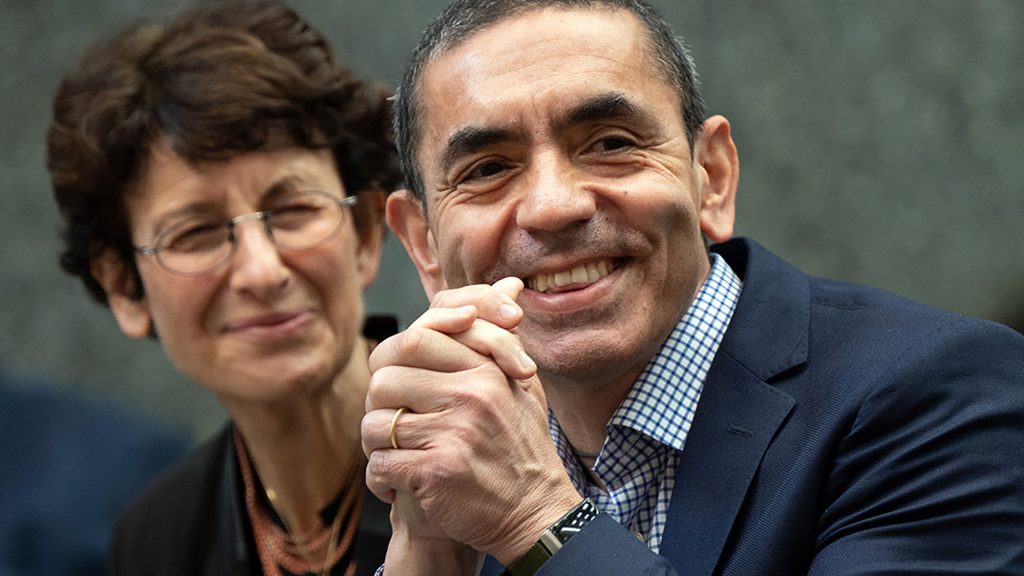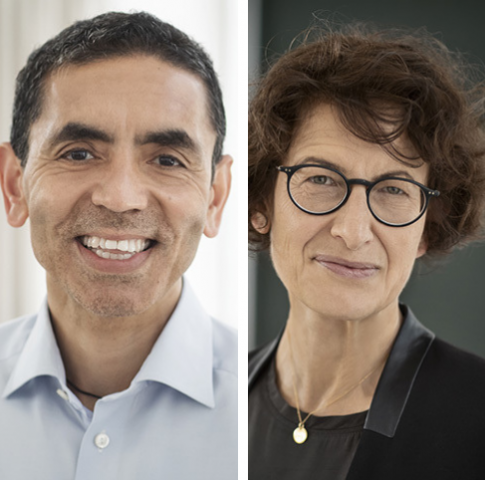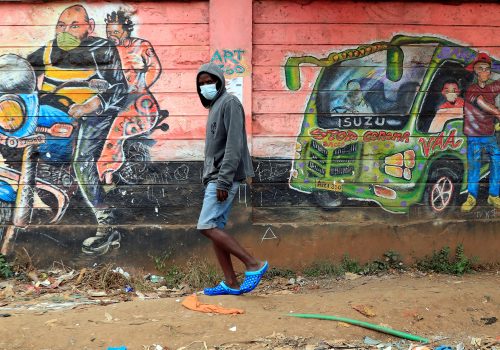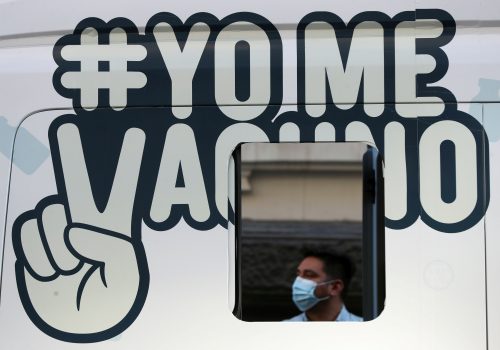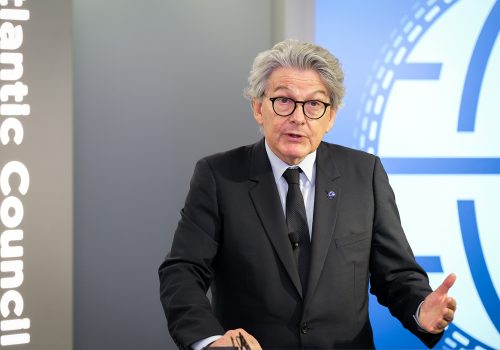Watch the full event
BioNTech co-founders Uğur Şahin and Özlem Türeci joined the Atlantic Council to talk about their pursuit to develop messenger RNA (mRNA) vaccines, including the COVID-19 vaccine, and how they work on common passions as a couple. They, along with Pfizer Chairman and Chief Executive Officer Albert Bourla, will receive the Atlantic Council’s Distinguished Business Leadership Award for their accomplishments on Wednesday, November 10. Below, edited for length and clarity, is Şahin and Türeci’s conversation with David Gelles, a columnist and business reporter at the New York Times.
DAVID GELLES: Uğur, as you think back to some of your work earlier in your career when you were studying immunotherapy and oncology, those were fundamental experiences you had, but did you ever expect that the work you were doing then—twenty and thirty years ago—would now lead you to a moment where you were addressing such a severe and immediate concern like the COVID-19 pandemic?
UĞUR ŞAHIN: Definitely not. My research started as a young immunologist asking a question: How can we use the mechanisms of our immune system to fight cancer? So we wanted to develop cancer immunotherapies, and infectious disease was not on our focus when we started our work. I imagined that we could develop cancer immunotherapies that would be useful to treat cancer in a personalized fashion.
DAVID GELLES: And Özlem, you had very similar interests at the start of your scientific and research career as well, also studying immunology. What drew you to the study of immunology and specifically cancer, which was also a focus of yours from an early age?
ÖZLEM TÜRECI: Cancer is a very complex disease, which makes it very interesting for a scientist, so that was one of the reasons. I was curious and wanted to learn more about this disease. And the second was that in medical school, when I made my first experiences with treating cancer patients, I could not believe that this cut-poison-burn type of approach would be the only one we could offer to these patients, and that was sort on the medical/clinical side, the reason which drew me to this disease.
DAVID GELLES: In addition to being colleagues and business partners, you also are a couple. You know one another as well as anyone. And one thing I’ve always wondered and never had the opportunity to ask you is what it’s like to work together. How do you divide the labor, if you will? Talk to us a bit about the collaborative process with someone who I imagine is not only your greatest collaborator, but probably also your best friend.
ÖZLEM TÜRECI: It’s a symbiosis, and I think that is the secret why it works so nicely. We have complementary skills so that we complement each other in the process. I pick up where Uğur leaves things and vice versa, and we have the same values and standards to what we want to deliver with our work. And this is a reason why even though we are married we can work very functionally together.
UĞUR ŞAHIN: We don’t see what we do as a work. It’s really part of our life. And therefore, it’s a wonderful chance to share this passion with my partner here and to really, every moment, decide whether we continue to discuss scientific topics, and sometimes we even have private topics, but we don’t discriminate between life-work balance. It’s one thing.
We don’t see what we do as a work. It’s really part of our life. And therefore, it’s a wonderful chance to share this passion with my partner.
UĞUR ŞAHIN, CO-FOUNDER AND CEO, BIONTECH
DAVID GELLES: I’m remembering a detail I included in an early article I had the good fortune of writing; it was a detail you shared with me where on the day of your wedding, after the ceremony was concluded, you went back to the office together and got back to work. Is that true?
ÖZLEM TÜRECI: That’s true, yes.
DAVID GELLES: Uğur, you were born in Turkey and your father, if I remember, immigrated to Germany when you were four years old to take a job at a Ford factory. And Özlem, you were born in Germany to parents who were Turkish immigrants. How did that experience shape your individual and scientific careers, and also your partnership perhaps?
ÖZLEM TÜRECI: I would not say that it shaped my career too much because our family was integrated, and I grew up in a way where I never faced any discrimination. At least, this was the way I felt. It probably impacted the way we interact with each other because there are sorts of mentality aspects that we share which probably come from this nationality that we also share, and that makes it easier to agree on values, on standards, and on general principles of doing things.
DAVID GELLES: Let’s fast forward now to 2008… You decided to put [your first company and academic careers] aside and create this new company, BioNTech. What was behind that decision? What gave you the conviction to walk away from what was, obviously, a fair amount of success in the realm you were already enjoying and go for this even more ambitious target?
UĞUR ŞAHIN: At the end of the day, it was very consistent with our vision. From the very beginning, our vision was to enable the development of what we call individualized immunotherapies. And the idea behind that is that every cancer is different, and every patient has a different cancer, and the way how we are treating cancer patients today is we are trying to find an existing drug and hope that this existing drug will be able to help this patient with a unique cancer. And we believe that the fundamental scientific challenge behind the failure of cancer treatments is that we disregard this complexity, and therefore we were interested in developing technologies that allow us to make tailored immunotherapies.
We accomplished that in the academic settings. That means we found a potential solution to solve this challenge. But it was very clear to us that we could not continue our work in the academic setting because you have to translate it. You have to bring it into clinical testing. You have to connect that to pharmaceutical development, which of course means many, many millions in investment. And therefore, it was just a consequence to move ahead and start a second company, which is dedicated to the development of individually tailored treatment.
DAVID GELLES: When it came time to start this company, you mentioned the need to also identify the appropriate technology. And of course, you landed on mRNA as one of the tools that could potentially deliver this radical new vision of truly tailored, customized medicine. What was it about the mRNA technology that you saw even though we didn’t have an mRNA vaccine that was in the wild yet and that was proven effective, what gave you the conviction that it might be the right tool for you?
ÖZLEM TÜRECI: This conviction, actually, it came very early, in the late 1990s, so many years before we even founded BioNTech. And what we did at that time was to compare those existing technologies which at that time were tried as cancer vaccines, and we also tried them and experimented with them, including mRNA. And what we saw in these comparisons was the huge potential of mRNA beyond those of other technologies, in particular with regard to its versatility. There are so many things you could do with it, if you would optimize it, and that was then the work of many years which followed. And what we also saw was the manufacturing or production aspect, that it could be feasible to be very fast with the production, and at a low cost of goods if optimized. And that’s a very important aspect for making personalized approaches, which is customized, on-demand production of an innovative treatment, viable. And these are the reasons why we first invested many years into this, which only was a vision at that time, mainly optimizing for all this potential, and it worked out.
DAVID GELLES: In addition to the work you were already pursuing at BioNTech, Uğur, in 2018 you made remarks at a conference that I was able to find where you thought beyond the potential for mRNA technology and what it might do for cancer, and you also addressed what it might one day do in the event of a truly global pandemic. What gave you the confidence and the vision to think even back then that this technology could potentially be used for something—although we didn’t have a name for it then—like COVID-19?
UĞUR ŞAHIN: At that time point, in 2018, we had already a lot of focus in the cancer field in our personalized cancer vaccines. We had treated hundreds of patients at that time with our personalized cancer vaccine approach and accomplished making vaccines within a few weeks and had seen in cancer patients that we can say that vaccines induce strong immune responses.
So the question was, what could be the utility of such a technology for the infectious disease field? And we believed that the utility would be to respond quickly to a newly emerging virus, for example in the case of an epidemic. And that was just a theoretical case that I was referring to, but at that moment of course I didn’t know that this could become reality two years later.
DAVID GELLES: It was early January of 2020 you read this famous article in the Lancet. Will you tell us what you had been thinking in the previous weeks, when I suspect you may have been hearing about what was happening in China and the emergence, the early cases of COVID-19, and then what both of you experienced when you saw that journal article?
UĞUR ŞAHIN: In mid-January I heard that there is a new outbreak in China with virus, and I was not concerned at that time point because we knew from the past that every year there is a new outbreak with a new virus strain. And I was not concerned. I just thought that this was going to happen and then it will be controlled in the coming weeks or months.
But on Friday, January 24, 2020 there was an article. It was the first scientific article describing the cases of this outbreak. The article was very informative. And one piece of information in the article was very disturbing, that there was evidence that the virus could spread from asymptomatic people. And the combination, the whole pattern that was described in this paper showed the pattern of an outbreak that is extremely difficult to control. And we got concerned that this is an outbreak which will not stay local, but could become a global pandemic very, very quickly.
DAVID GELLES: Özlem, was the same thought process essentially going through your mind as you realized the properties that this virus contained and thought about, in the interconnected global world we live in, just how difficult it might be to contain if it truly was as contagious as these early reports made it out to be?
ÖZLEM TÜRECI: When Uğur presented his thoughts, it was very easy for me to follow what he was suspecting. In fact, the numbers and the mechanisms we discussed made very clear that we probably were already in the midst of a smoldering pandemic. And Uğur came up with two potential scenarios: Either this would be a process in which within basically a few months only, the world population would be quickly decimated; or the other scenario, that it would take one year or so, a slower ramp up, which at the end of the day was what really happened. And so it did not take too much discussion to make clear that we had the obligation to try to contribute to a response, and this response had to be fast because we did not know which of these scenarios would then come true.
We had the obligation to try to contribute to a response, and this response had to be fast.
ÖZLEM TÜRECI, CO-FOUNDER AND CHIEF MEDICAL OFFICER, BIONTECH
DAVID GELLES: Things did start moving very quickly. Can you talk about those initial few days between when you received the genetic sequence from where you were able to have essentially the data you needed to start developing what might be an effective COVID-19 vaccine using mRNA technology?
UĞUR ŞAHIN: The genetic sequence of this virus was already available. We downloaded the sequence and asked the questions which part of this sequence could be useful for development of a vaccine. And based on prior applications of a related member of this virus family, we could rapidly identify the spike protein as a candidate, and we also selected domains of the spike protein as potential candidates. And already on the Sunday after, we had designed sequences for our vaccines—eight candidates—that we sent to our collaborators, to our team to start designing and producing those vaccine candidates. And on the next Monday, we just met our team and started to discuss how to execute this project.
DAVID GELLES: How recently in the matter of years or decades is the rapid development of eight potential candidates—would that have even been possible? I mean, had COVID-19 come around just a decade ago, could you have done the work you did that quickly to identify candidates? Or are we really at this inflection point moment where the technology is finally allowing us to do these rapid responses in a way that just wasn’t possible even a few years ago?
ÖZLEM TÜRECI: Science and our technology were [only] just now mature enough to show this type of rapid response, and also opening this design space of several candidates, which was necessary because we had so many unknowns, so we had to put a couple of horses into this race. Even twelve months ago, we might not have been in the position to respond this fast. So it’s, indeed, an inflection point.
Science and our technology were [only] just now mature enough to show this type of rapid response… we had so many unknowns, so we had to put a couple of horses into this race. Even twelve months ago, we might not have been in the position to respond this fast.
ÖZLEM TÜRECI, CO-FOUNDER AND CHIEF MEDICAL OFFICER, BIONTECH
UĞUR ŞAHIN: And what is really interesting is it was just in time. But it was like we had built a plane to fly, but never used the plane to fly an infectious disease vaccine. That means we had never done an infectious disease clinical trial. So we had a number of unknowns. We knew that the technology could work, but we did not have the definitive proof that it’s going to work. And that was, of course, dealing with unknowns. And if you’re dealing with unknowns, you need to use multiple candidates. So we not only generated eight, but more than twenty candidates for a vaccine.
DAVID GELLES: You were also around this time… establishing your relationship with Pfizer. You had already been working with Pfizer on an influenza vaccine. Talk to us briefly about the foundations of that partnership and what it meant that you already had inroads with a global company like Pfizer at this critical moment.
ÖZLEM TÜRECI: We were already working with Pfizer. Our flu partnership started in 2018. It was still at the pre-clinical stage, but even though it was just one-and-a-half years working together, we already had a very good understanding of the capabilities of our partner. We knew everyone in the different teams. And we knew that the values were in sync. We had the same values, and in particular, being driven by scientific data. And that was a very good foundation for us after we very quickly understood that this project—Project Lightspeed—would very fast come to a point where we would need a global partner. It was very clear that Pfizer would be definitely the preferred one. And we approached them, and they were open to working with us.
DAVID GELLES: That summer, though, there was still no guarantee that this would work. What was the most difficult part of that summer and fall of 2020 as the clinical trials proceeded with haste, of course, but still at a judicious pace, and you still had to get to that place where the data told you what we all hoped we would find? What was the most difficult part of the clinical trials and the waiting?
UĞUR ŞAHIN: One really difficult aspect was the selection of the phase three clinical candidate. You can start with twenty candidates, but at the end of the day you have to decide and select the one which will go into the phase three clinical trial. And even until almost the end of July, we had two candidates which were in the race and we had to make a decision. And actually, the data supporting the decision-making came in just on July 24, and we had a meeting with the colleagues from Pfizer on the same day to discuss all data and we made a decision to select BNT162b2 as a candidate. And a few days ago, the preferred candidate was another one. It was a surprise to their whole team and to the world that we had just selected a candidate for the phase three clinical trial which came in with even better data.
And then we had then the phase three clinical trials started. We had to wait to get the data. This is a double-blind clinical trial, so that means half of the trial participants got the vaccine and the other half got placebo, and they didn’t know. They didn’t, of course, until the day of evaluation. They didn’t know whether the vaccine would be effective, whether it would be able to prevent infections in a reasonable manner.
DAVID GELLES: Some would consider a vaccine with 60 percent efficacy a success, 70 percent efficacy a real success. What was your reaction, when I think it was almost exactly a year ago this week if I have the timing right, that you saw the data that it was well over 90 percent effective?
ÖZLEM TÜRECI: It was an unbelievable moment when we got this data. And you have to imagine it was on a Sunday and we knew that in the afternoon we would get the data, and up to that point there was no way of knowing whether we would see any efficacy at all or whether placebo and vaccine would show the same result. It was—it was a scary day. And then we heard from [Pfizer Chairman and Chief Executive Officer] Albert Bourla that there is efficacy, the vaccine works, and it’s 95 percent, which was first unbelievable and thereafter just wonderful to hear. We felt blessed.
DAVID GELLES: How did you two celebrate?
ÖZLEM TÜRECI: We were in a lockdown, so that was not on the table, this option. We treated ourselves to a cup of tea.
DAVID GELLES: The production was not entirely without its hiccups. What were the major challenges of scaling up the production of the BioNTech-Pfizer vaccine, especially in those critical first months?
UĞUR ŞAHIN: Usually, if you develop a vaccine, you start preparing the manufacture of the vaccine about two to three years before the vaccine reaches the market. That means the team has a lot of time to improve the manufacturing process, to adapt the details, to scale up the production capacities. And when we started our project in January 2020, we knew that we don’t have this time of three years. We really wanted not only to get an effective and safe vaccine but enable manufacturing and supply of the vaccine worldwide.
We really wanted not only to get an effective and safe vaccine but enable the manufacturing and supply of the vaccine worldwide.
UĞUR ŞAHIN, CO-FOUNDER AND CEO, BIONTECH
So that was the reason why we already started in January/February in planning how to scale up our manufacturing. You have to imagine that in 2019—that means a year before this pandemic—our scale for manufacturing was in the range of ten thousand to fifty thousand doses per year, yeah? And in the pandemic, for pandemic supply, of course, we had the aim to deliver at least one hundred million doses. That means both companies, our company and Pfizer were working and scaling up the manufacturing.
And we had accomplished to produce, to scale up the production of the mRNA which was fully in our hands, but we were also dependent on the scale up of the second step, which is the lipid nanoparticle, yeah, which depends on raw materials from third parties. And during the last step of the scale-up process, we realized that one of the components—that one of the lipids—does not have the quality required to manufacture for supply. That means the team was working day and night for several weeks to identify the root cause and find a solution for that.
I mean, in that few weeks, we lost the opportunity to produce fifty million doses. So our plan was in 2020 to make one hundred million doses, but we could only produce fifty million doses, which was a setback. But later on, we were able to manage that and to even further increase our manufacturing capacity.
DAVID GELLES: And today, how many people around the world have now benefited from the BioNTech-Pfizer vaccine?
UĞUR ŞAHIN: We produced in the meantime 1.8 billion doses that are already delivered. And so we managed to supply about 150 countries and regions worldwide. We have more than 750 million people who already received our vaccine, which is incredible because such a ramp up has never happened in the history of pharmaceuticals. And it just shows how incredible, incredible an accomplishment of our teams, but also with the support of corporation partners is.
DAVID GELLES: If we all remember from our earlier part of the conversation, it was not infectious diseases that initially intrigued you and was the rationale for even the founding of this company, but it was the potential for mRNA technology to address the Emperor of All Maladies: cancer. Are you still at work on vaccines that could potentially treat cancer? And beyond that, where else do you now see the potential application of mRNA?
ÖZLEM TÜRECI: We have never stopped. Also during Project Lightspeed, our cancer vaccine programs and treating patients in our clinical trials with our cancer vaccines has continued. It was slowed down by the pandemic as the entire industry has been slowed down with regard to clinical trial conduction, but we have continued and now we are accelerating even those programs, both for our fully personalized vaccines as well as for our off-the-shelf cancer vaccines.
And not only vaccines; mRNA can, for example, be used to deliver cancer-targeting monoclonal antibodies. What we had done with Ganymed before with conventional technologies—recombinant-protein technologies—we are now using mRNA and ditching the middlemen, meaning the protein-production plants. And the same, for example, for cytokines, which are an important part for immune therapy in cancer.
And we are going beyond cancer into other infectious diseases which might be much higher hanging fruits as compared to COVID-19. These are diseases which have been with humans for many millions of years—for example, malaria, or tuberculosis, or HIV.
And this is sort of the first wave. We also want to bring mRNA into indications such as autoimmune diseases because mRNA not only can help to communicate to the immune system to attack, for example, cancers or viruses; it can also communicate to not attack and to calm down, which is needed for autoimmunity or allergy indications, for example.
DAVID GELLES: What do you now see as you look into the future and think about the potential for us, as a civilization, to treat some of these diseases? What, Uğur, seems possible that didn’t seem possible even just two years ago?
UĞUR ŞAHIN: The biggest change is that we have been transformed as a company. We had, of course, a bold vision to develop personal cancer immunotherapies, but the innovation of mRNA goes beyond cancer. It is actually what we believe the most important medical-technology progress in the last forty years. So this technology, if combined with the rapidly growing knowledge about diseases about better understanding of the mechanisms, could help us to design treatments for diseases with a high medical need which have not been solved.
We had, of course, a bold vision to develop personal cancer immunotherapies, but the innovation of mRNA goes beyond cancer. It is actually what we believe the most important medical-technology progress in the last forty years.
UĞUR ŞAHIN, CO-FOUNDER AND CEO, BIONTECH
Malaria and tuberculosis and HIV are examples, but there are other examples. We have, for example, neurodegenerative diseases. We have autoimmunity. We have rare diseases. And what we can also do is to combine this technology with other type of tools—for example, with CRISPR/Cas. CRISPR/Cas could be delivered with messenger RNA. When we combine that with, for example, gene therapy, we could use the technology also for modifying inherited diseases.
The number of opportunities is endless. And the challenge is, of course, to mobilize the scientific community in a meaningful fashion and engage in collaborations to address all these opportunities in a diligent fashion, because drug development, of course, requires diligence, and it requires several years of development, and it requires also financing. And so we have a lot of opportunities, but there are also a number of challenges ahead to increase productivity of research in the field.
Watch the full event
Further reading
Thu, Oct 28, 2021
G20 leaders can rescue low-income countries by redistributing their IMF windfall
AfricaSource By
If the G20 enhances the impact of IMF Special Drawing Rights by sending them on to low-income countries, it could add up to a synchronized global recovery.
Wed, Sep 22, 2021
Chilean President Sebastián Piñera: COVID-19 solidarity offers hope for tackling climate change
New Atlanticist By
The Chilean leader joined other political, business, and health leaders at the annual conference hosted by the Atlantic Council’s Adrienne Arsht Latin America Center alongside the United Nations General Assembly.
Tue, Sep 21, 2021
EU Commissioner Thierry Breton: Trust in the US ‘has been eroded’
New Atlanticist By
Breton outlined developments in the European Union’s vaccination efforts, digital policy agenda, and cooperation with the United States.
Image: Ugur Sahin and Özlem Türeci sit in the front row as Cologne honors the Biontech founders in the city hall. Photo via DPA/Reuters.
